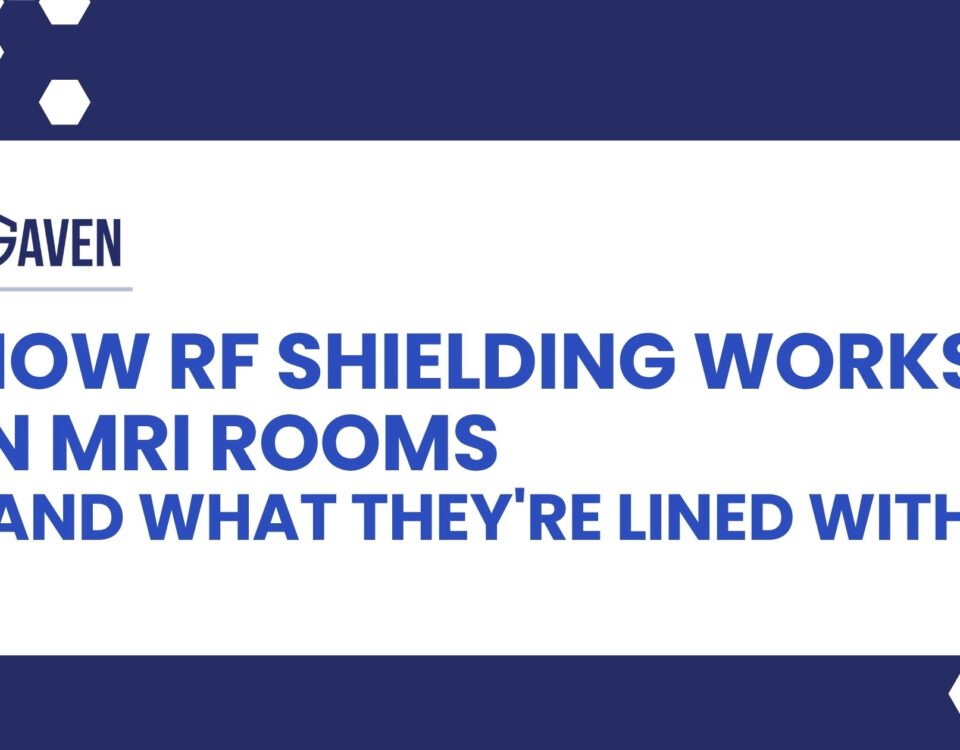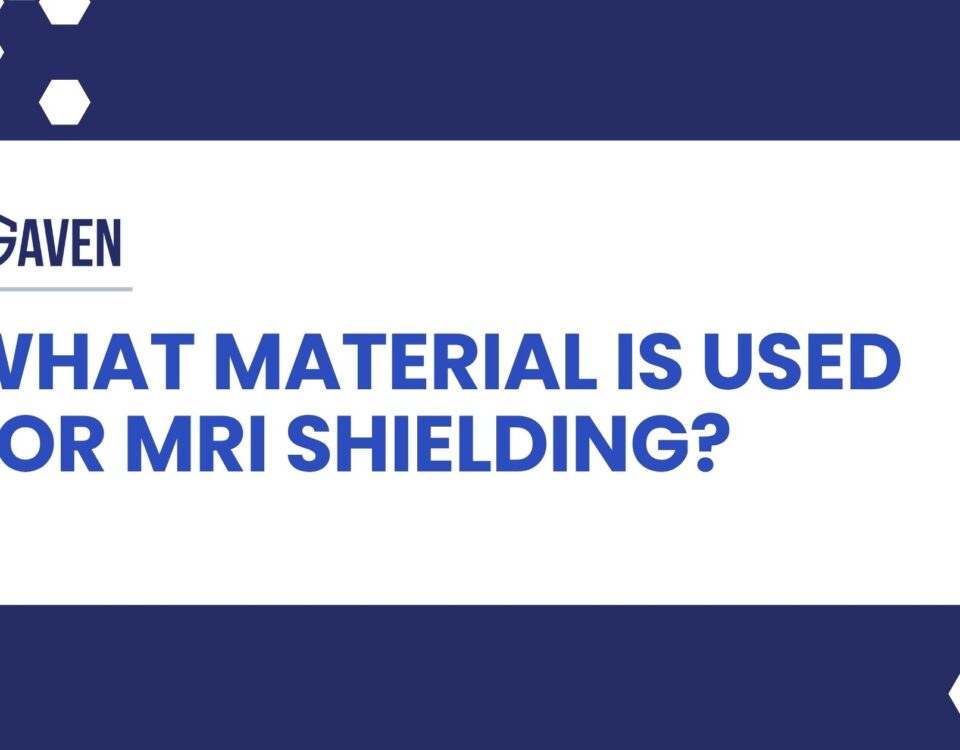


Active and Passive Shielding in MRI
July 8, 2025


MRI Shielding Companies
July 8, 2025Designing an MRI suite is as much a safety protocol as it is an engineering project. Every aspect of the space—from wall construction to electrical routing—must be optimized to control powerful magnetic fields and block disruptive radiofrequency (RF) interference. MRI room shielding is not optional. It’s a clinical, operational, and regulatory necessity.
Shielding failures can lead to image degradation, equipment damage, and even patient injury. In worst-case scenarios, non-compliance can halt operations altogether. That’s why MRI shielding is one of the most scrutinized components of diagnostic suite design. It requires not just physical containment—but a full-spectrum mitigation strategy.
Gaven Industries provides performance-guaranteed MRI shielding solutions that combine RF, magnetic, acoustic, and structural components into one cohesive system. With nearly 50 years of industry experience, Gaven’s shielding systems are engineered to meet the most demanding requirements across new builds, retrofits, and modular installations.
This article outlines the critical MRI room shielding requirements that healthcare planners, architects, and facilities managers must understand to ensure a safe, compliant, and diagnostically precise installation.
Why are MRI rooms shielded?
MRI scanners operate with two distinct electromagnetic properties: high-strength static magnetic fields and sensitive radiofrequency pulses. Each presents unique risks:
- Magnetic fields, particularly from 1.5T and 3T magnets, extend beyond the scanner room. Uncontrolled fringe fields can interfere with nearby equipment, pose projectile hazards, and violate public safety limits defined by the 5 Gauss line—the threshold beyond which magnetic exposure becomes hazardous to individuals with implanted medical devices.
- Radiofrequency (RF) interference from external sources—like cell phones, telemetry systems, or elevators—can corrupt image quality, introduce artifacts, or trigger false diagnostics.
Without properly engineered containment, both types of interference can jeopardize the diagnostic value of MRI studies and the operational safety of the surrounding space. Even seemingly minor electromagnetic disturbances, such as those caused by improperly shielded fluorescent lights or power cables, can degrade MRI image sequences.
Shielding resolves both threats. It preserves image integrity, protects nearby electronics, and ensures safe use of the scanner for patients and staff. Without proper shielding, even routine scans could be compromised by ambient EMI or the stray influence of the scanner’s own magnetic footprint.
“An MRI suite isn’t just a room—it’s a finely tuned electromagnetic environment. Shielding is what makes that possible.” — John J. Gaviglia, Founder, Gaven Industries
What material is used for RF shielding in MRI?
MRI RF shielding materials must be conductive, corrosion-resistant, and mechanically reliable over decades of use. At Gaven Industries, we build Faraday cage enclosures using:
- Soldered copper panel systems for maximum attenuation and long-term stability
- Galvanized steel systems for applications requiring added structural strength or value engineering
Copper is the gold standard in MRI RF shielding due to its superior conductivity and attenuation across critical frequency bands. In clinical testing, copper demonstrates better performance in the 10 kHz to 100 MHz range—essential for protecting the ultra-sensitive signals emitted by hydrogen nuclei during imaging sequences.
Galvanized steel, while slightly less performant at higher frequencies, offers robust mechanical strength and is often preferred in facilities where durability and cost are key considerations—such as modular units or hybrid imaging environments.
These enclosures are designed with:
- Seamless joints or soldered seams for electrical continuity
- Integrated grounding paths to eliminate potential difference issues
- Filtered penetrations for power, data, and gas lines
- Waveguide HVAC assemblies that allow airflow without RF leakage
Gaven’s systems are rigorously tested to IEEE-299 and MIL-STD-285 standards. We provide certification for attenuation levels and field uniformity, ensuring the shield performs as expected under live imaging conditions. For clients, this means uninterrupted workflow, reduced rescan risk, and better patient throughput.

What material is used for magnetic shielding in MRI?
Magnetic shielding uses high-permeability materials to absorb and redirect the fringe fields produced by the MRI’s static magnet. These materials—typically silicon steel, electrical steel, or mu-metal—create a magnetic path of least resistance, guiding field lines away from sensitive areas.
While active magnetic shielding is standard in modern MRI systems, passive shielding remains essential in cases where:
- Fringe fields extend into occupied or sensitive zones
- The magnet is installed near ferromagnetic infrastructure
- There’s a need to shield adjacent equipment (such as EEG labs or ICU rooms) from magnetic distortion
Unlike RF shielding, magnetic shielding must be designed according to the specific magnet’s fringe field map, which varies with magnet strength, orientation, and room geometry. A 3T MRI, for example, may require floor and ceiling shielding in addition to lateral protection, depending on the scanner’s footprint and the facility’s structural configuration.
Key considerations include:
- Material selection: Higher permeability materials offer stronger field attenuation but may require thicker layers or lamination
- Wall and floor integration: Shielding is often built into floor slabs or wall cores for maximum containment and compliance with ANSI/AAMI safety limits
- Coordination with active shielding: Modern MRI systems feature internal fringe control coils, but passive steel shielding is still required in proximity-constrained installations
At Gaven, our engineers use magnet-specific field modeling software to simulate fringe behavior and recommend material thicknesses, lamination patterns, and layout adjustments. All magnetic shielding systems are built to align with 0.5 mT (5 Gauss) zone boundaries, ensuring both safety and code compliance.
How are MRI machines shielded?
MRI machines are shielded using a combination of internal and external solutions, each designed to control a different form of electromagnetic influence:
- Active shielding: Secondary magnet coils within the MRI cancel fringe fields before they extend outward. These are installed at the time of manufacture and calibrated based on magnet strength (e.g., 1.5T, 3T).
- Passive shielding: Ferromagnetic materials surrounding the room absorb residual fields, especially in directions not mitigated by active shielding.
- RF shielding: The room itself functions as a Faraday cage, using conductive panel systems to block both incoming and outgoing RF signals that could compromise image quality.
- Penetration shielding: Doors, windows, HVAC, and utility lines are all sealed using engineered passthroughs, filters, and waveguides.
MRI shielding is not isolated to a single layer or system. It is a complete architectural strategy—coordinated from magnet to envelope, and every point in between. Gaven integrates shielding into the entire room design, including finishes, access controls, mechanical systems, and electrical layout.
“Shielding isn’t just about protecting the magnet—it’s about engineering the entire environment around it. That’s where Gaven delivers unmatched value.” — John J. Gaviglia
What happens if you enter an MRI room with metal?
MRI environments are strictly controlled for a reason: metal objects can become dangerous projectiles when exposed to the scanner’s magnetic field. The force exerted by a 1.5T or 3T magnet on ferromagnetic objects is not hypothetical—it’s immediate, powerful, and potentially deadly. Numerous case studies and incident reports have demonstrated how improperly screened tools, oxygen tanks, or patient implants have resulted in serious injury and equipment damage.
Common risks include:
- Projectile incidents, where ferromagnetic tools or objects are pulled into the bore at high velocity—sometimes from across the room
- Burns, caused by RF-induced heating of conductive objects like ECG leads, hearing aids, or implants
- Image interference, even from small fragments or cosmetics containing metallic particles, which can create voids or ghosting artifacts in imaging sequences
Facilities must implement:
- Zone-based access controls, as outlined in the American College of Radiology (ACR) 4-Zone Model, which governs how and where personnel may access MRI suites
- Screening protocols for all staff and patients, including detailed intake for implants, piercings, dental work, and medical devices
- Signage, training, and lockdown policies to prevent accidental exposures or unauthorized access
MRI safety violations are not only dangerous—they carry regulatory and legal consequences. The Joint Commission and FDA both track MRI-related incidents, and failure to implement best practices can result in fines, liability claims, and accreditation issues.
What are the legal requirements for MRI room shielding?
MRI shielding is governed by both federal regulations and professional guidelines that cover electromagnetic safety, structural compliance, and environmental performance.
Key frameworks include:
- The American College of Radiology (ACR) MRI Safety Guidelines, which define fringe field management, zone access, and recommended shielding strategies for clinical environments
- The NFPA 99 Health Care Facilities Code, which includes detailed requirements for grounding, EMI mitigation, and fire safety in MRI environments
- FDA regulations, including 21 CFR Part 820, which governs medical device approval and electromagnetic compatibility for diagnostic equipment
Legal requirements include:
- Documentation of shielding effectiveness, such as Gauss line maps and RF attenuation reports. These documents are often required during facility inspections and vendor commissioning.
- Posted signage and restricted access controls, including magnet warning symbols, zoning information, and staff training logs
- Annual safety audits or performance certification, often required for Joint Commission accreditation, new equipment installations, or building code updates
Gaven Industries supports all documentation and testing as part of its MRI shielding engagements. Our post-installation packages include magnetic field verification, RF test reports, and digital records aligned with inspection requirements.
“MRI shielding isn’t complete until it’s certified—and that’s where many projects fall short. We stay on-site until it’s verified, validated, and compliant.” — John J. Gaviglia
What are the technical requirements for MRI room shielding?
MRI shielding isn’t just about blocking fields—it’s about creating a controlled electromagnetic and environmental environment that allows sensitive equipment to function at peak precision.
Environmental specifications:
- Temperature: MRI electronics and superconducting magnets require consistent room temperatures between 65°F and 75°F, as fluctuations can affect performance and quench risk
- Humidity: Optimal range is 45%–60% relative humidity to prevent condensation, which can cause corrosion or electrical arcing in shielded assemblies
Electrical systems:
- Isolated power circuits, often delivered through dedicated panels and transformers, to reduce electromagnetic interference from building infrastructure
- Dedicated grounding systems, bonded directly to the shielding enclosure, to prevent ground loops and ensure Faraday cage continuity
- Filtered electrical penetrations, which prevent EMI pathways through power and signal conduits
Doors and windows:
- RF-shielded assemblies, constructed using soldered copper or galvanized steel to maintain uninterrupted shielding
- Failsafe air seal doors that maintain RF and magnetic integrity even during high-frequency usage in clinical workflows
- Custom shielded windows, constructed with multi-layer conductive glass and tested for attenuation performance
All of these systems must work in concert to meet shielding specs, environmental stability targets, and building code mandates. At Gaven, we manufacture and install each shielding component in-house—ensuring consistent quality and a single point of accountability.
How are MRI rooms shielded?
MRI rooms are shielded using a multi-layered, integrated approach, combining:
- RF shielding: Panelized Faraday cage systems with soldered seams, filtered penetrations, and waveguide air systems
- Magnetic shielding: Passive steel paneling, slab shielding, and architectural integration for 5 Gauss containment
- Structural integration: Walls, floors, and ceilings built to accommodate shielding loads and regulatory access requirements
- Environmental and electrical systems: Shielded lighting, HVAC air handling, isolated circuits, and emergency power isolation
At Gaven Industries, we handle shielding from planning to post-installation testing. Our turnkey process includes:
- Site evaluations and fringe field simulations, based on manufacturer specs and structural realities
- Material selection based on magnetic load, shielding effectiveness, and budget requirements
- Installation by trained technical crews, following hospital infection control standards and construction staging protocols
- Final certification for shielding effectiveness and code compliance, including RF attenuation testing and Gauss mapping
This comprehensive approach ensures that every MRI room we build or upgrade performs to spec—clinically, electrically, and structurally.
“MRI shielding doesn’t end at installation. It ends when it’s tested, verified, and ready for clinical operation.” — John J. Gaviglia
Protect your facility and ensure compliance with MRI shielding standards. Contact Gaven Industries to design or retrofit your MRI room with expert shielding solutions built for performance, safety, and regulatory peace of mind. We don’t just install panels—we engineer high-performance imaging environments from the inside out.




